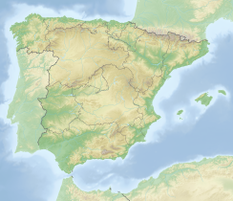Peñón de Vélez de la Gomera
| Peñón de Vélez de la Gomera | ||
 Peñón de Vélez de la Gomera (seen from the Moroccan coast) |
||
| Geographical location | ||
|
|
||
| Coordinates | 35 ° 10 ′ 21 ″ N , 4 ° 18 ′ 1 ″ W | |
| Waters 1 | Alboran Sea , Mediterranean | |
| length | 470 m | |
| width | 190 m | |
| surface | 1.9 ha | |
 In the picture from 1920 the Peñón can still be clearly recognized as an island, while the small La Isleta in the east (right) seems to be directly connected to the Peñón |
||
Peñón de Vélez de la Gomera ( Span. Peñón means boulder ) is a Spanish exclave on Morocco's Mediterranean coast and a Plaza de soberanía .
geography
The peninsula, consisting of a 77 m high rock, is located about 120 kilometers southeast of Ceuta and 125 kilometers west of Melilla . It has been connected to the mainland by a narrow isthmus since 1934. The exclave has an area of approximately 19,000 m² and a height of up to 87 meters above sea level. The only settlement is a small military station with around 60 military personnel .
The present-day peninsula was originally an island (a second island or a peninsula connected to the Peñón by a narrow ledge was La Isleta 40 meters east), until massive storms in 1934 washed large amounts of sand into the narrow channel between the islands and the African continent . Since then, the Peñón de Vélez de la Gomera has been a peninsula (or consists of two peninsulas) and separated from Morocco by the shortest land border on earth at 85 meters.
history
Peñón de Vélez de la Gomera was occupied by privateers at the beginning of the 16th century . In the fight against piracy in this area, a Spanish ship crew under the command of Pedro Navarro was able to take the island on July 23, 1508. In 1522 the rock was lost through betrayal of Muley Mohamed , lord of Badis ; the entire Spanish garrison was killed here. The region, which had meanwhile been brought under control by the Wattasids , was handed over to the Ottomans by Bou Hassoun in 1554 . After a first attempt had failed the year before, García de Toledo was able to recapture the island for Spain on September 6, 1564 on the orders of Philip II .
In the 17th and 18th centuries the island was besieged several times (1680, 1701, 1755, 1781 and 1790), but the Spaniards were able to prevent another loss. In the 19th century, Peñón de Vélez de la Gomera had lost its military importance, so that Spain temporarily considered blasting the rock and the facilities on it in 1871, but did not pursue these plans.
When Morocco was granted independence by France and Spain in 1956, Peñón de Vélez de la Gomera remained with Spain. This was justified by the fact that the rock had not previously belonged to Morocco.
cards
Individual evidence
- ↑ territoriosolvidados.com ( Memento of July 14, 2012 in the Internet Archive )



